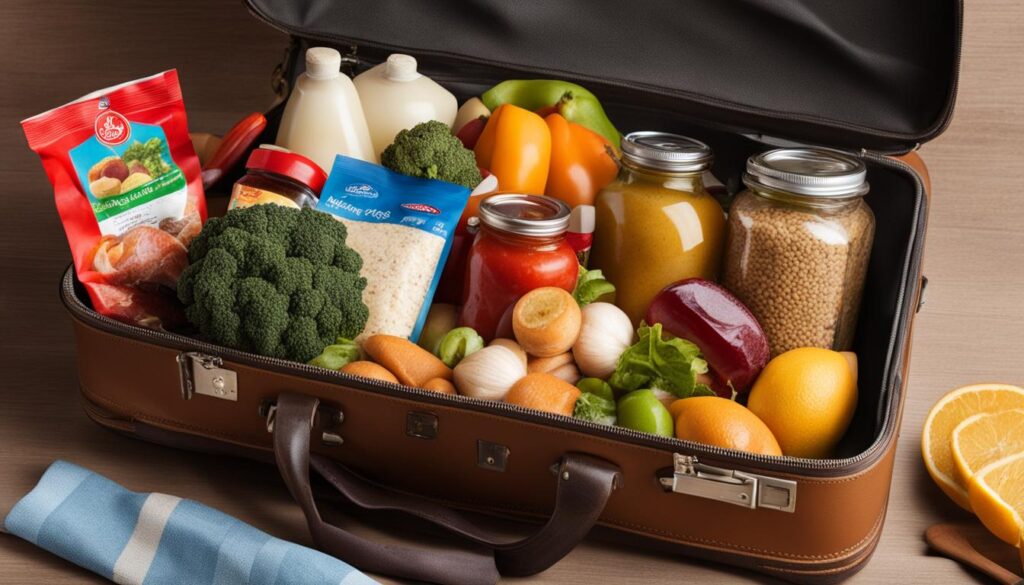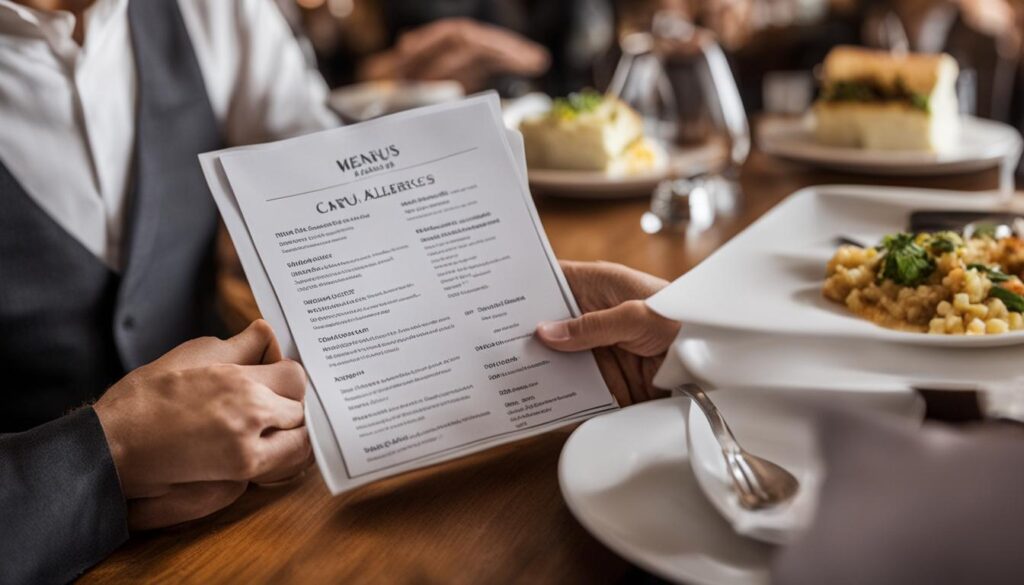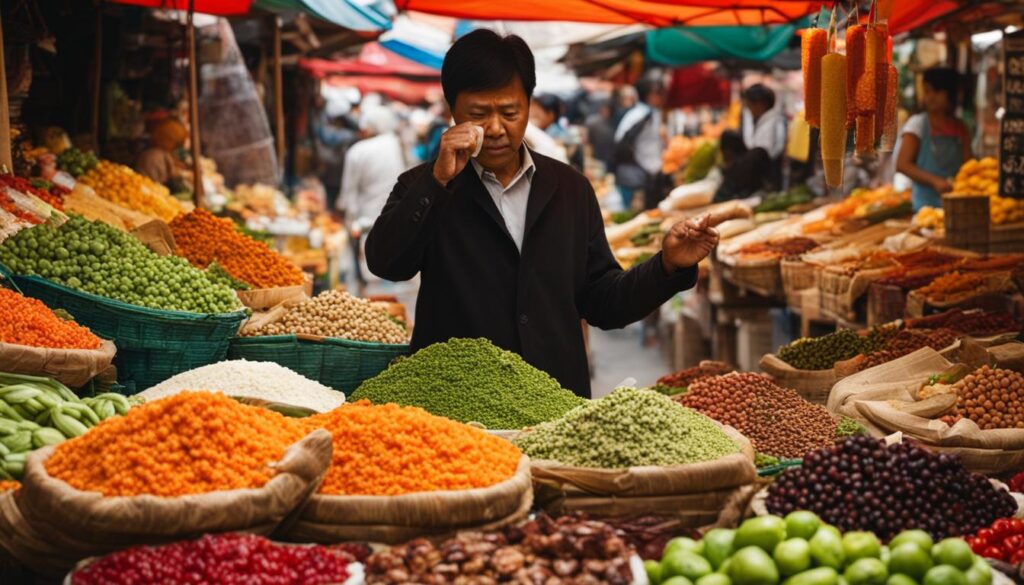Traveling with food allergies or sensitivities can be a daunting experience. The fear of exposure to potential allergens and the uncertainty of finding safe dining options can make planning a trip seem overwhelming. However, with the right strategies and preparation, you can overcome these challenges and enjoy your travels.
In this article, we will provide you with essential travel tips for food allergies or sensitivities. You will learn how to manage your allergies on the go, plan ahead for your trip, navigate restaurants, pack safe snacks, communicate your allergies, avoid cross-contamination, and prepare for medical emergencies.
By following our advice, you can experience stress-free travel without compromising your health and wellbeing. So, how can you overcome food allergies or sensitivities while traveling? Let’s explore the solutions together!
Understanding Your Food Allergies or Sensitivities
Managing food allergies or sensitivities on the go can be a challenge, but understanding the difference between allergies and sensitivities and knowing your own triggers is essential for staying safe while traveling.
An allergic reaction occurs when your immune system reacts to a food as if it were a threat to your body. This can cause a wide range of symptoms, from hives and itching to stomach cramps, vomiting, and difficulty breathing. Sensitivities, on the other hand, may cause similar symptoms but don’t involve an immune response. Instead, they are often related to digestive issues, such as bloating, gas, and diarrhea.
Some of the most common food allergens include peanuts, tree nuts, shellfish, eggs, dairy, soy, and wheat. However, each individual may have unique triggers, so it’s important to identify your own sensitivities and allergies by keeping a food journal and/or seeking medical advice.
| Allergen | Symptoms |
|---|---|
| Peanuts | Swelling, hives, trouble breathing |
| Tree nuts | Swelling, hives, nausea, vomiting |
| Shellfish | Rash, stomach cramps, difficulty breathing |
If you have food allergies or sensitivities, it’s important to carry any necessary medications with you, such as an epinephrine auto-injector (commonly known as an EpiPen). You should also research safe dining options and communicate your dietary needs to restaurant staff or others who may be preparing your food.
Planning Ahead: Preparing for Your Trip
Traveling with food allergies or sensitivities doesn’t have to be daunting. Planning ahead is key to ensuring a safe and enjoyable trip. Here are some allergy-friendly travel hacks to help you stay safe and prepared:
Research Safe Dining Options
Before your trip, research restaurants and grocery stores at your destination that cater to individuals with food allergies or sensitivities. Many online resources can help you find allergy-friendly establishments, such as AllergyEats and Allergenius. Use these tools to make a list of safe dining options in advance.
Pack Safe Snacks
Packing safe snacks is an essential part of allergy-friendly travel. Nutritious options include fresh fruit, trail mix, or protein bars. Always read the labels carefully and avoid any products with potential allergens. Also, don’t forget to pack any medically necessary foods or supplements.
Communicate Your Dietary Needs
When booking flights or hotels, inform them of your dietary restrictions as soon as possible. Most airlines and hotels can accommodate dietary needs with advance notice. When dining out, communicate your allergy or sensitivity to the waitstaff and chefs. Always double-check that the food is safe before consuming it.
Take Precautions
Stay prepared in case of an allergic reaction. Bring your emergency medications, such as EpiPens, and make sure they are easily accessible. Also, consider bringing a translated copy of your allergy or sensitivity in case of language barriers.
By planning ahead and taking precautionary measures, you can stay safe and enjoy your trip despite food allergies or sensitivities.
Navigating Restaurants: Dining Out Safely
Traveling with food allergies or sensitivities can make dining out a stressful experience, but it doesn’t have to be. With some preparation, careful planning, and effective communication, you can enjoy delicious meals while minimizing the risk of allergic reactions.
Reading menus: When selecting a restaurant, review the menu beforehand to identify safe options. Look for items that are unlikely to contain the allergens you need to avoid. Avoid dishes with ambiguous descriptions and ask for clarification from the server or chef if necessary.
Communicating with restaurant staff: Once you arrive at the restaurant, inform your server of your food allergies or sensitivities. Explain exactly what you need to avoid and how severe your reaction can be. Ask to speak with the chef if possible, and double-check that they understand your requirements.
Navigating cross-contamination risks: Even when you select a safe dish, there is still a risk of cross-contamination if the food comes into contact with allergens. Speak to the server or chef about potential issues, such as shared cooking surfaces or utensils. Ask if the chef can prepare your meal separately to minimize the risk of exposure.
Finding allergy-friendly restaurants: Many cities now have restaurants that cater specifically to customers with food allergies or sensitivities. Websites like Allergy Eats and Find Me Gluten Free can help you find allergy-friendly dining options while on the road.
With these strategies, you can navigate dining out safely and confidently while traveling with food allergies or sensitivities.
Allergy-Friendly Travel Snacks: Staying Nourished on the Go
When you have food allergies or sensitivities, finding safe and nutritious snacks while on the go can be a challenge. That’s why it’s essential to pack allergy-friendly travel snacks before you hit the road. Not only will this ensure that you have something safe and satisfying to eat, but it can also save you money and time by avoiding airport or convenience store markups. Here are some tips for eating safely with food allergies or sensitivities during travel:
Make Your Own Snack Packs
One easy way to ensure you have safe travel snacks is to prepare your own snack packs. Start by choosing a variety of nutritious, allergy-friendly snacks like fresh fruit, gluten-free crackers, and nut-free trail mix. Then, portion out the snacks into small bags or containers that fit easily into your carry-on luggage. Having your own prepared snacks is not only safe, but it can also provide a sense of comfort during travel.
Look for Allergy-Friendly Labels
When purchasing snacks at convenience stores or airport kiosks, look for products with allergy-friendly labels. Many brands now produce snacks that are free of common allergens such as tree nuts, dairy, and soy. These labels make it easier to identify which products are safe to eat when you’re on the go.
Additionally, if you’re unsure about an ingredient or whether a product is safe for you to eat, use your smartphone to scan the product’s barcode and check the ingredients label or verify the product with your allergist first.
Find Allergy-Friendly Vendors
Some airports have food vendors that cater specifically to individuals with food allergies or sensitivities. Do some research ahead of time to see if these vendors are available in your terminal. If not, look for restaurants or cafes with allergy-friendly options on their menus. Many establishments offer gluten-free or plant-based dishes and have staff trained in accommodating dietary restrictions. Some well-known chains even offer specialized allergen menus that can be a life-saver for individuals with food allergies or sensitivities.
Bring Non-Perishable Snacks for Emergencies
Even with careful planning, sometimes unexpected situations can occur while traveling. That’s why it’s always a good idea to bring non-perishable snacks as a backup. Protein bars, rice cakes, and dried fruit are all great options that can be easily stored in your luggage and don’t require refrigeration. These snacks can be a lifesaver if you’re stuck on long flights or transportation delays.
Language and Cultural Barriers: Communicating Your Allergies
Traveling to new countries with different languages and cultures can present unique challenges for managing food allergies or sensitivities on the go. To effectively communicate your dietary requirements, it’s important to be prepared with some strategies before your trip.
Here are some tips for navigating language and cultural barriers:
- Research in Advance: Look up common food allergies and phrases related to your dietary restrictions in the local language before you arrive. This will help you communicate your needs more effectively.
- Use Food Allergy Translation Cards: These cards, available for purchase online, provide clear information about your food allergies or sensitivities translated into the language of the country you are visiting. You can show these cards to waitstaff or chefs to ensure your needs are understood.
- Ask for Recommendations: Ask locals or hotel staff for recommendations on allergy-friendly restaurants. They may be able to suggest places where the staff speak your language and have experience accommodating food allergies or sensitivities.
- Avoid High-Risk Foods: When in doubt, stick to simple, fresh foods that are unlikely to contain your allergen. Avoid foods with unknown ingredients or that have been cooked in shared equipment.
Remember, communication is key when managing food allergies or sensitivities in new and unfamiliar settings. Don’t be afraid to speak up and ask questions to ensure your safety and enjoyment while traveling.
Safe Travel Practices: Preventing Cross-Contamination
Staying safe with food allergies or sensitivities while traveling involves taking precautions to prevent cross-contamination. Here are some best practices to follow:
- Bring your own utensils and containers: Packing your own utensils and containers can help prevent cross-contamination in shared spaces.
- Wash your hands frequently: Washing your hands before eating or handling food can help reduce the risk of contamination.
- Communicate your needs: Let restaurant staff, hotel staff, and travel companions know about your food allergies or sensitivities. Ask questions and confirm that your requests have been understood.
- Avoid buffet-style dining: Buffet-style dining can be risky for individuals with food allergies or sensitivities. Instead, opt for restaurants with single-serve dishes or dishes prepared to order.
- Be mindful of shared spaces: In communal dining areas, be aware of the risk of contamination from shared utensils, condiments, and serving dishes.
- Read food labels: Take the time to read food labels and ingredient lists carefully, even for items that seem safe or familiar.
By following these safe travel practices, you can help reduce the risk of cross-contamination and enjoy your travel experience free of allergic reactions.
Traveling with Medications and Emergency Plans
When traveling with food allergies or sensitivities, it’s crucial to prepare for unexpected allergic reactions. Ensure you carry all necessary medications, such as epinephrine auto-injectors, at all times. Pack extra medication in case of emergencies and place them in your carry-on bag. Remember to keep medications within their original packaging for identification purposes.
Create an emergency plan that outlines the steps to take in case of an allergic reaction, including the use of medication. Share this plan with your travel companions and have a copy with you at all times. Research nearby hospitals or medical facilities in advance, so you know where to seek help if necessary.
Remember, preparation is key to staying safe and enjoying your travels. By taking the necessary precautions and carrying medications and emergency plans, you can overcome any challenges that may arise, giving you peace of mind on your journey.
Traveling with Support: Enlisting Help from Others
Dealing with food allergies or sensitivities can be stressful while traveling. Yet, enlisting help from others can make a significant difference. Here are some tips on how to travel with support and overcome food allergies or sensitivities while on the go:
Communicating with Travel Companions
Traveling with companions who understand your dietary needs can greatly reduce stress. Be upfront and communicate your allergies or sensitivities with travel partners before the trip. Provide them with a list of safe foods and explain how accidental exposure can cause harm. Work together to plan meals and choose safe restaurants.
Getting Assistance from Hotel Staff
Hotels can be a great resource for travelers with food allergies or sensitivities. Upon arrival, inform the hotel staff of your needs and ask for recommendations on nearby restaurants that cater to special dietary needs. Additionally, check if hotel restaurants can accommodate your dietary requirements. Most hotels are happy to help and may even provide you with a refrigerator for your safe snacks.
Utilizing Online Communities
Joining online communities that focus on travel with food allergies or sensitivities can provide valuable advice and recommendations. These communities can help you identify safe dining options and connect with locals who have similar dietary restrictions. Some popular online resources include AllergyEats, Gluten-Free Globetrotter, and Food Allergy Research & Education.
Traveling with food allergies or sensitivities doesn’t have to be stressful. By enlisting help from others, you can overcome challenges, explore new cuisines and have an enjoyable travel experience.
Traveling Abroad: International Considerations
Traveling abroad with food allergies or sensitivities requires additional preparation and caution. Navigating food allergies or sensitivities while on vacation can be challenging, especially in countries where food labeling regulations and cultural attitudes towards dietary restrictions differ from those in the United States.
When planning your international trip, consider the following:
- Research common allergens and ingredients in the local cuisine.
- Learn key phrases in the local language to communicate your dietary restrictions.
- Contact restaurants and hotels in advance to discuss your dietary needs.
- Consider staying in accommodations with kitchen facilities to prepare your own meals.
When dining out, keep the following in mind:
- Be cautious of hidden allergens and cross-contamination.
- Use allergy translation cards to communicate your dietary needs to restaurant staff.
- Bring your own allergy-friendly snacks in case safe options are unavailable.
Additionally, be aware of cultural differences in food labeling. Some countries may not require comprehensive ingredient labels, making it more difficult to identify potential allergens. When in doubt, stick to simple meals with ingredients you are familiar with.
Remember, preparation is key when navigating food allergies or sensitivities while on vacation. By researching the local cuisine and communicating your dietary needs to restaurants and accommodation providers, you can enjoy international travel while staying safe and healthy.
Conclusion
Traveling with food allergies or sensitivities can be a daunting task, but with the right preparation and knowledge, you can enjoy your travels without compromising your health. Remember to understand your specific food allergies or sensitivities, plan ahead by researching safe dining options and packing allergy-friendly travel snacks, communicate your dietary needs clearly, and enlist the help of others. Take extra precautions when traveling abroad and always carry necessary medications and emergency plans.
By following these strategies, you can navigate any challenges that may arise and have a safe and enjoyable travel experience.

















































